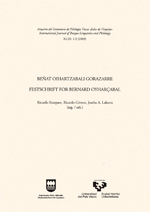Aoristo Perifrástico, perfectivo y pluscuamperfecto: Leizarraga vs. Lazarraga
##plugins.themes.bootstrap3.article.main##
##plugins.themes.bootstrap3.article.sidebar##
Publicado
16-04-2009
Gontzal Aldai
Resumen
In this paper I compare the use of the Old Basque (archaic) Periphrastic Aorist (har nezan 'I took') and of the Past Perfect-Perfective or Modern Perfective (hartu nuen 'I took') in the 16thcentury writers Leizarraga (from Labourd) and Lazarraga (from Alava). While the Periphrastic Aorist in Leizarraga is already well known among scholars (having given rise to various disputes), the use of the same verb form in the newly found manuscript by Lazarraga is extremely interesting in order to compare it with Leizarraga's use. My main conclusions from this comparison are the following: a) Lei zarra ga shows a more systematic usage of the Periphrastic Aorist to express a typical perfective (main-clause narrative); this may be due to a conscious attempt to achieve a written formal register. b) Conversely, Lazarraga is more conservative regarding the use of the Periphrastic Aorist in subordinate temporal clauses conveying "narrative anteriority", e.g.When Jesus entered Capernaum, a centurion came to him.
Cómo citar
Aldai, Gontzal. 2009. «Aoristo Perifrástico, Perfectivo Y Pluscuamperfecto: Leizarraga Vs. Lazarraga». Anuario Del Seminario De Filología Vasca "Julio De Urquijo" 43 (1-2):19-36. https://doi.org/10.1387/asju.1670.
##plugins.themes.bootstrap3.article.details##
Sección
Artículos
Esta obra está bajo una licencia Creative Commons Atribución-NoComercial-SinDerivadas 4.0 Internacional.


